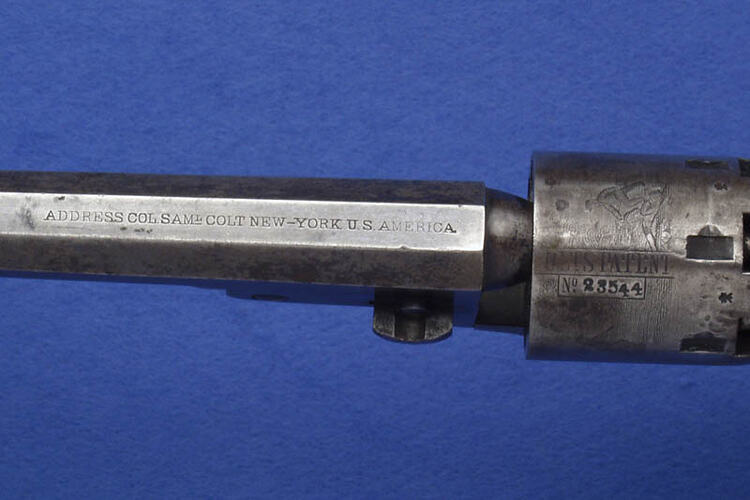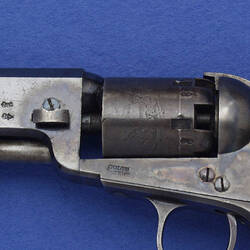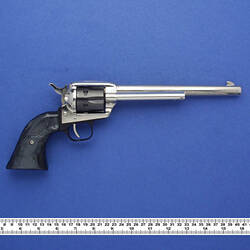Samuel Colt was born in Hartford, Connecticut, on the 19 July 1814, one of six children of Christopher and Sarah Caldwell Colt. In his early youth he attended a farm in Glastonbury, Connecticut, attended the Amherst Academy for some years before being expelled after a Fourth of July prank involving explosives, and worked in his father's silk mill in Ware, Massachusetts.
As a child, the young Colt was often around firearms. Noted Colt historian, R.L. Wilson, quotes Colt's biographer, Henry Barnard, who recalls a seven-year old Colt in 1821 who had wandered off from his family and friends only to be found 'sitting under a tree in the field, with a pistol taken entirely to pieces, the different parts carefully arranged around him, and which he was beginning to reconstruct. He soon, to his great delight, accomplished the feat'.
On 2 August 1830, the then 16 year old Colt sailed from Boston to Calcutta aboard the 'Corvo'. It was during this voyage that the idea for a revolving firearm was developed. Some sources credit Colt's observation of the ship's wheels and its clutch system that locked the wheel in line with any spoke that was in line with it. Carving it from a block of wood, he gave shape to the revolving cylinder and percussion hammer that would become a staple feature of nearly all revolving firearms to follow. The original carved wooden components are now part of Samuel Colt's private collection, Wadsworth Atheneum.
When Colt returned to America he presented his ideas to his father and family friend, Henry L. Ellsworth, Commissioner of the US Patent Office. Working through Anson Chase, a gunsmith in Hartford, Colt supervised the production of some of the earliest models of his design.
To further his ideas and generate the financial support he would require, Colt went on a tour of the US and Canada giving lectures on the effects of laughing gas under the name of 'Dr Coult of Calcutta'. Much of his earnings were directed back to gunsmiths in Hartford, Albany and Baltimore who produced prototype firearms - in all about nine rifles, one shotgun and sixteen pistols. In 1835, after some three years of lecturing, Colt travelled to Europe and took out patents in England and France - countries were it was anticipated patent infringements might occur, as they later did in Belgium - before returning to America to complete his American patents which were granted on 25 February 1836. This patent offered Colt almost exclusive monopoly over the main features of his revolver until 1857.
Before the issuing of the US patent had been finalised, Colt had already set about creating a stock company and factory to begin production of his firearms. Based at Paterson, New Jersey, Colt's first firm was formed in March 1836 under the name of The Patent Arms Manufacturing Company. A sales office and showroom followed shortly after in New York. The success of the Paterson factory was short lived however. By 1841 it had gone into bankruptcy and closed permanently in 1842, putting a temporary halt to Colt's future endeavours.
The Texan-Mexican War (1846-48) was to have a profound affect on the development of Colt's firearms and push Colt back into the market as America's leading firearm manufacturer. When Ranger Samuel Walker approached Colt in 1846 with authority from the War department to secure more Colt firearms for the massing troops on the Mexican border, Colt was without factory, machinery or even models from which to recommence production. Nonetheless, designs were redrawn from memory with improvements being made along the way, and Colt approached Eli Whitney, a government arms contractor for military muskets. Whitney agreed to manufacture the design on that which Walker and Colt had come to agree and a contract dated 4 January 1847 for 1000 Colt revolvers was created. Like his earlier experiences, Colt eagerness to begin saw production commence before the signing of the contract.
By 1860 continued exhaustion began to make an impact on Colt's health. He had for years previous suffered from Rheumatic Fever, but now with the increased pace of production brought about by the American Civil War, his health began to deteriorate rapidly. He died on 10 January 1862 and was buried in Hartford. His wife paid her last remembrances in the published work named after their estate, Armsmear: 'Hartford knew on that day that she had lost one of her noblest sons. The flags were all displayed at half-mast on the day he died. In many a home his prosperity had aided there were mourning hearts; and all felt then, that he who that day had fallen was among those whose place could never be filled'.
References:
Haven, Charles T. and Belden, Frank A. (1940). A History of the Colt Revolver and the Other Arms Made by Colt's Patent Fire arms Manufacturing Company from 1836 to 1940, William Morrow and Co.
Swayze, Nathan (1967). 51 Colt Navies - The Model 1851 Colt Navy, its variations and markings, Gun Hill Publishing Co.
Wilson, Robert L. (1985). Colt - An American Legend, Abbeville Publishing Group.
More Information
-
Keywords
-
Localities
Connecticut, United States of America, New Jersey, United States of America, London, England, United Kingdom
-
Authors
-
Article types



